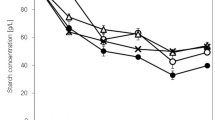Abstract
The direct conversion of starch hydrolysate (15 Dextrose Equivalent) to ethanol using a coimmobilizate of amyloglucosidase and Saccharomyces cerevisiae was studied in a batch stirred tank reactor. The performance of the reactor for various system parameters viz. stirrer speed, pH, initial substrate concentration and temperature has been studied. The ethanol productivity is limited by inhibition for initial substrate concentrations above 75 g/l. The optimum pH and temperature of reaction is 5.0 and 30 °C respectively.
Similar content being viewed by others
References
Mosbach, K.: Togetherness through immobilisation. In: Bohak, Z., and Sharon, N. (Eds): Biotechnological Applications of Proteins and Enzymes, pp. 141–152 London: Academic Press 1977
Chithra, N.; and Baradarajan, A.: Studies on Co-immobilisation of amyloglucosidase and Saccharomyces cerevisiae for direct conversion of starch to ethanol. Proc. Biochem. 24(6), 1989 208–211
Hartmeier, W.: Basic trials on the conversion of cellulosic materials to ethanol using yeast coimmoblized with cellulolytic enzymes. In: M. Moo-Young, C. Vezma and K. Singh (Eds): Advances in Biotechnology, Vol. 3, pp. 377–382, Toronto: Pergamon Press 1981.
Hartmeier W.; Jankovic, E. D.; Forster, U. and Tramm-Werner: Ethanol formation from lactose using yeast and bacterial cells coimmobilized with β-galactosidase. In: Biotech. Europe 84, 1, pp 415–426. Pinner GB.: On line Publications 184
Hagerdal, B.: Comparison between immobilized Kluyveromyces fragilis and Saccharomyces cerevisiae coimmobilized with β-galactosidase, with respect to continuous ethanol production from concentrated whey permeate. Biotechnol. Bioeng., 27 (1985) 914–916
Lee, J. H.; Pagan, R. J.; and Rogers, P. L.: Continuous simultaneous saccharification and fermentation of starch using Zymononas mobilis. Biotechnol. Bioeng. 25 (1983), 659–669
Ueda, S.; Zennin, C. T.; Monteiro, D. A.; and Park, Y. K.: Production of ethanol from raw cassava starch by a nonconventional fermentation method. Biotechnol. Bioeng. 23 (1981) 291–299
Hall, R. D.: J1. Inst. Brewing, 62 (1956), 222–226.
Miller, G. L.: Use of dinitrosalicylic acid reagent for determination of reducing sugar. Anal. Chem. 31 (1959) 426–428
Ghose, T. K.; and Bandhyopadhyay, H. H.: Rapid ethanol fermentation in immobilized yeast cell reactor. Biotechnol. Bioeng. 22 (1980) 1489–1496
Kay, G. and Crook, E. M.: Coupling of enzymes to cellulose using chloro-s-triazines. Nature 216 (1967) 514–515
Hagerdal, B.: An enzyme coimmobilized with a microorganism: The conversion of cellobiose to Ethanol using β-glucosidase and Saccharomyces cerevisiae Biotechnol. Bioeng. 26 (1984) 771–774
Author information
Authors and Affiliations
Rights and permissions
About this article
Cite this article
Chithra, N., Baradarajan, A. Direct conversion of starch hydrolysate to ethanol using a coimmobilizate of amyloglucosidase and saccharomyces cerevisiae in batch stirred tank reactor. Bioprocess Engineering 7, 265–267 (1992). https://doi.org/10.1007/BF00386236
Received:
Issue Date:
DOI: https://doi.org/10.1007/BF00386236




